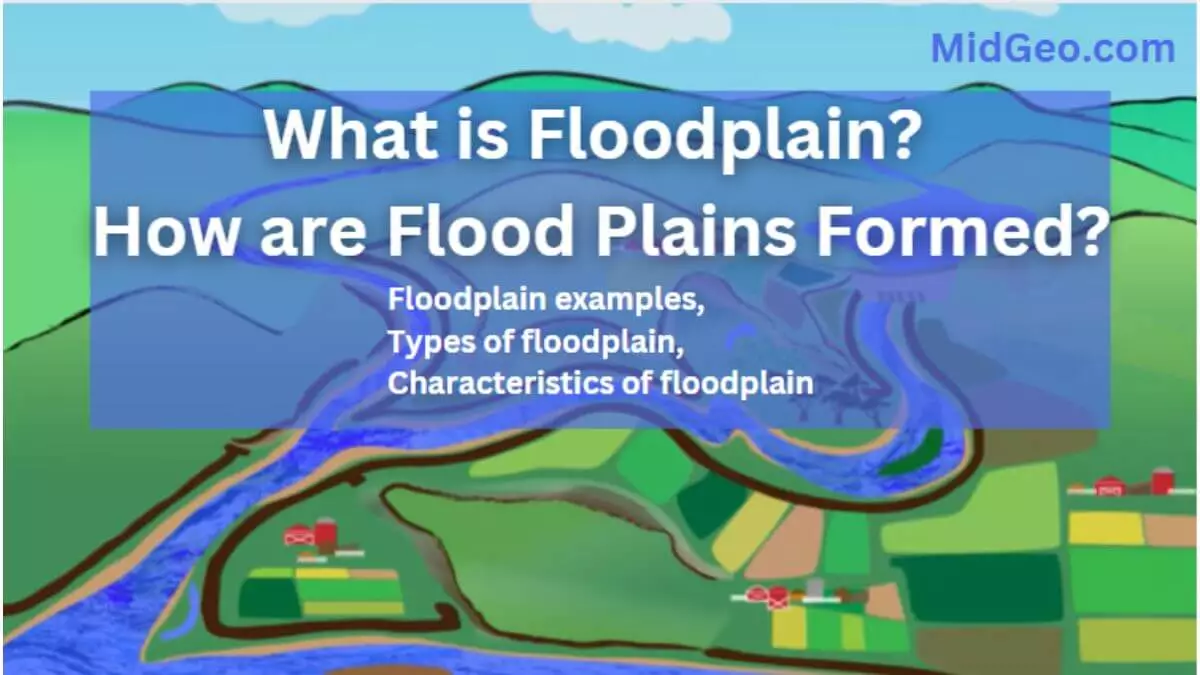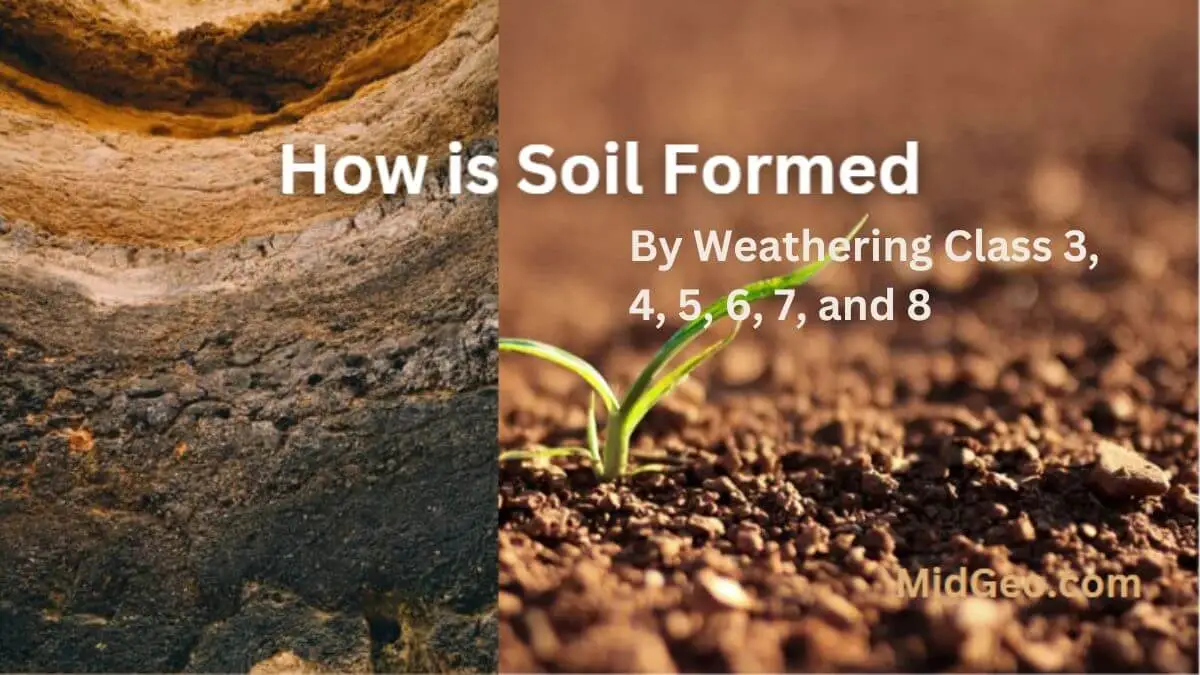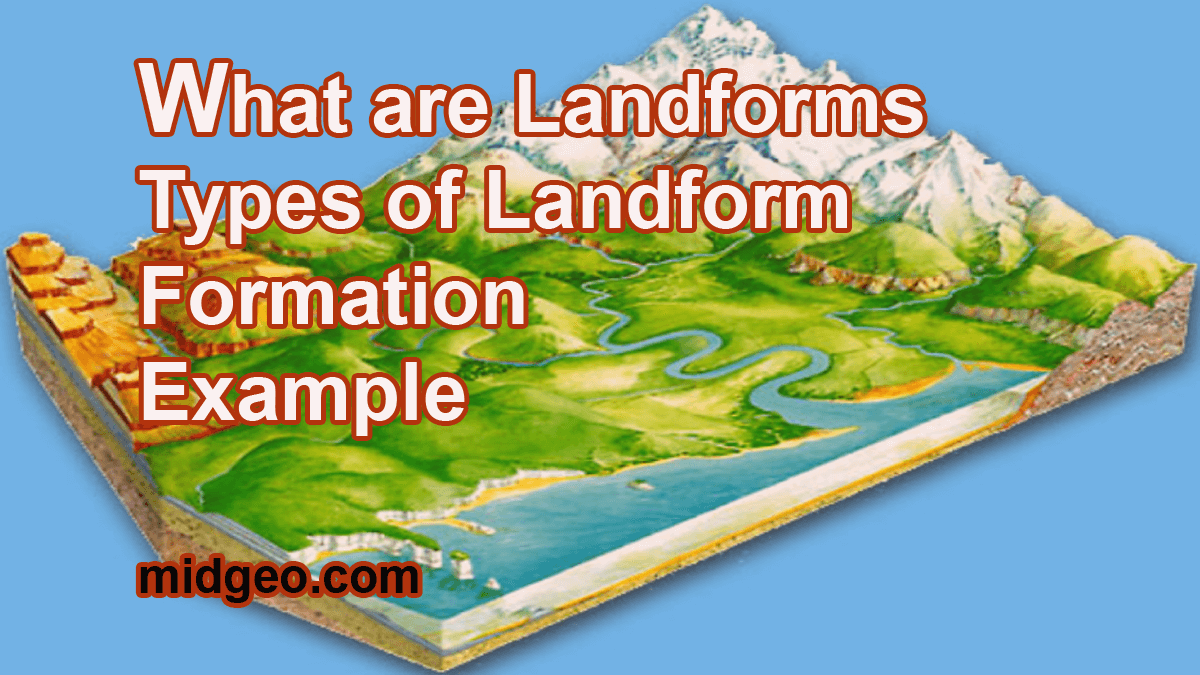
Floods are one of the most destructive natural disasters, causing significant damage to property and loss of life. A floodplain is a low-lying area near a river or stream that is prone to flooding. Floodplains play a crucial role in the natural functioning of river systems and provide important habitats for wildlife. In this article, we’ll explore what is floodplain? How are Flood Plains Formed? It’s examples, and characteristics.
What is Floodplain?
A floodplain is a flat or gently sloping area adjacent to a river or stream that is regularly inundated by floodwaters. Floodplains are typically composed of alluvial soils, which are rich in nutrients and provide fertile grounds for plant growth. Flood plains vary in size and shape and can stretch for miles along a river or stream.
You May Like: What is a Beach? How Are Beaches Formed?
Types of Floodplain
There are several types of floodplain that can be classified based on their geomorphology, hydrology, and ecology. Here are some of the common types of floodplain:
- Alluvial Floodplain: Alluvial floodplains are formed by the deposition of sediment by flowing water. They are often characterized by their flat topography and fertile soil.
- Coastal Floodplain: Coastal floodplains are located near the ocean or other large bodies of water. They are subject to flooding from storm surges, high tides, and other coastal hazards.
- Riverine Floodplain: Riverine floodplains are located along rivers and streams. They are shaped by the natural process of flooding and are characterized by their meandering channels and the deposition of sediment.
- Tidal Floodplain: Tidal floodplains are located in estuaries and other areas where freshwater and saltwater mix. They are subject to flooding from tides and storm surges.
- Urban Floodplain: Urban floodplains are located in cities and other developed areas. They are often characterized by impervious surfaces such as roads and buildings, which can exacerbate flooding by preventing water from being absorbed into the ground.
- Agricultural Floodplain: Agricultural floodplains are used for farming and are often characterized by their fertile soil and proximity to water sources. They are subject to flooding, which can cause significant damage to crops and infrastructure.
Understanding the different types of floodplain is important for effective flood risk management and floodplain management strategies.
Floodplain Examples
Floodplains are found in many regions worldwide, including the Nile in Egypt, the Mississippi in the United States, the Amazon in Brazil, and the Ganges in India. Floodplains are also present in Europe, Asia, Africa, and Australia.
- 10 Importance of Geography in the World: Why Studying Geography Matters for Individuals and Nations
- World Environment Day 2025: Date, Theme, and Significance
- Relative vs. Absolute Location | Definition & Examples
- What is a Beach? How Are Beaches Formed?
- List of Landforms A to Z on Earth
How are Flood Plains Formed?

Floodplains are formed by the natural processes of erosion and deposition. Rivers and streams carry sediment downstream and deposit it along their banks during floods. Over time, this process can create a flat or gently sloping area adjacent to the river or stream, which is the floodplain.
During floods, the force of the water can erode the banks of the river or stream, causing sediment to be transported downstream. As the floodwaters recede, the sediment is deposited on the floodplain. This process of erosion and deposition can continue over time, resulting in the expansion of the floodplain.
The shape and size of a floodplain are determined by several factors, including the slope of the land, the velocity of the water, and the amount of sediment carried by the river or stream. In some cases, human activities such as damming and channelization can also affect the formation of floodplains.
Formation
Floodplains are formed by the natural process of rivers and streams overflowing their banks and depositing sediment on the adjacent land. This sediment builds up over time, creating a flat and fertile plain that is ideal for agriculture and human settlements.
Significance:
Floodplains play an important role in the natural functioning of river systems. They serve as natural storage areas for floodwaters, which helps to reduce the risk of downstream flooding. Floodplains also provide important habitats for wildlife, including fish, birds, and amphibians.
In addition to their ecological significance, floodplains also have important economic and cultural value. They provide fertile grounds for agriculture and are often used for grazing livestock. Floodplains also provide opportunities for recreation, such as fishing, boating, and birdwatching.
Characteristics of Floodplain
Floodplains are characterized by their flat and fertile terrain, which is ideal for agriculture. They also contain a wide variety of plant and animal species that are adapted to living in this unique ecosystem. Floodplains are prone to flooding, which can cause damage to crops, infrastructure, and human settlements.
Flood plain in Bangladesh
Bangladesh is a country located in the delta of the Ganges, Brahmaputra, and Meghna rivers. The country is prone to flooding, and the floodplain areas cover approximately 80% of the country’s land area. The floods in Bangladesh can cause severe damage to crops, infrastructure, and livelihoods.
Agriculture
Floodplain agriculture is the practice of growing crops on the fertile soil of a floodplain. This type of agriculture is popular in many parts of the world because of the nutrient-rich soil and the abundance of water. However, floodplain agriculture can also be risky, as floods can destroy crops and cause significant economic losses.
How do Flood Plains Make Agriculture Possible?
Floodplains make agriculture possible by providing nutrient-rich soil and an abundant supply of water. When a river or stream overflows its banks and floods a floodplain, it deposits sediment that contains valuable nutrients such as nitrogen, phosphorus, and potassium. This makes the soil on the floodplain highly fertile and suitable for growing crops.
The flooding also provides an ample supply of water for irrigation, which is crucial for crop growth, especially in arid regions. Floodplains are often located near water sources such as rivers, streams, and lakes, which provide a reliable supply of water for irrigation.
Additionally, the periodic flooding of floodplains helps to control pests and weeds, which can be a significant problem in agriculture. Floods can drown pests and weeds, and the nutrient-rich soil helps to promote the growth of crops, which can outcompete weeds for resources.
However, flooding can also pose a risk to agriculture on floodplains, especially if it is too frequent or severe. Floods can destroy crops, cause soil erosion, and lead to significant economic losses. Therefore, farmers on floodplains must manage the risk of flooding by adapting their farming practices and using flood-resistant crops or other strategies to minimize the impact of flooding.
Floodplain Ecology
Floodplain ecosystems are unique and support a diverse range of plant and animal species. These ecosystems are shaped by the natural process of flooding, which helps to redistribute nutrients and support plant growth. Floodplains also provide important habitat for migratory birds, fish, and other wildlife.
- Creating Natural Landscapes
- What is Cultural Geography
- Political Geography Important Definition
- Formal Region Definition in Geography
- Abiotic Factors- What are Actually Abiotic Factors
Why Might It be a Bad Idea to Build a House in a Floodplain?
Building a house in a floodplain can be a bad idea for several reasons:
- Increased risk of flooding: Floodplains are prone to flooding, and building a house in a floodplain increases the risk of damage or destruction due to floodwaters. Even a small amount of water can cause significant damage to a home.
- Higher insurance costs: Homeowners insurance is typically more expensive for homes located in floodplains. This is because the risk of flooding is higher, and insurance companies may have to pay out more claims.
- Environmental damage: Building homes in floodplains can lead to environmental damage, including loss of wetlands, destruction of wildlife habitat, and increased sedimentation in nearby waterways.
- Expensive repairs: If a home in a floodplain is damaged by flooding, the repairs can be costly. Even if the homeowner has insurance, the deductible can be high, and the homeowner may need to pay out of pocket for additional repairs.
- Disruption of emergency services: In the event of a flood, emergency services may not be able to reach homes in a floodplain due to blocked roads and other hazards. This can put residents at risk if they need emergency assistance.
Overall, building a house in a floodplain can be risky and costly. It is important to consider the potential risks and take steps to mitigate them, such as elevating the home above flood level, using flood-resistant materials, and having a plan for evacuating in the event of a flood.
FAQs: What is Floodplain? How are Flood Plains Formed?
Q.1: Can floodplains be developed?
A. Yes, floodplains can be developed, but development in flood-prone areas can increase the risk of property damage and loss of life during floods.
Q.2: How do floodplains help to reduce flooding downstream?
A. Floodplains act as natural storage areas for floodwaters, which helps to reduce the volume and velocity of water downstream.
Q.3: How can we protect floodplains?
A. Floodplains can be protected through land-use planning, zoning, and conservation efforts. Wetland restoration and the preservation of riparian habitats can also help to protect floodplains.
Q.4: How to Prevent Flooding on a Floodplain?
Preventing flooding on a floodplain is a complex issue that requires a combination of natural and human-made interventions. Natural interventions include protecting and restoring wetlands and floodplains, while human-made interventions include building levees, dams, and other flood control structures. Proper land use planning and management can also help reduce the risk of flooding on a floodplain.
Floodplains are important natural features that play a crucial role in the functioning of river systems. They provide important habitats for wildlife and have significant economic and cultural value.
Understanding the formation and significance of floodplains is important for effective land-use planning and conservation efforts.
By protecting floodplains, we can help to reduce the risk of downstream flooding and ensure the sustainability of river systems for future generations. I hope you find a clear idea about What is floodplain? how it’s form, example and characteristics. Thanks for being with us.





